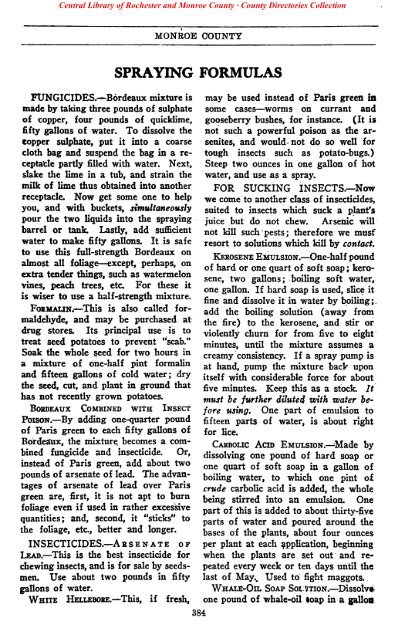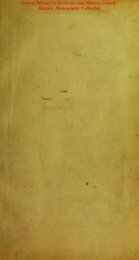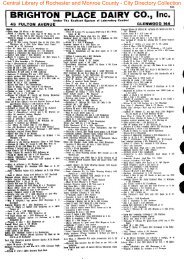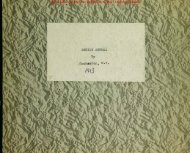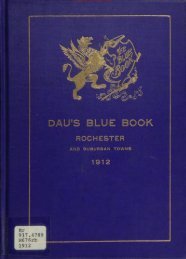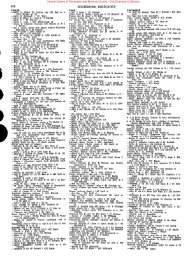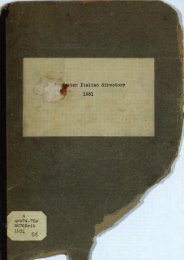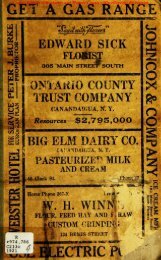The Farm Journal Illustrated Rural Directory of Monroe County, New ...
The Farm Journal Illustrated Rural Directory of Monroe County, New ...
The Farm Journal Illustrated Rural Directory of Monroe County, New ...
You also want an ePaper? Increase the reach of your titles
YUMPU automatically turns print PDFs into web optimized ePapers that Google loves.
Central Library <strong>of</strong> Rochester and <strong>Monroe</strong> <strong>County</strong> · <strong>County</strong> Directories Collection<br />
MONROE COUNTY<br />
FUNGICIDES.—Bordeaux mixture is<br />
made by taking three pounds <strong>of</strong> sulphate<br />
<strong>of</strong> copper, four pounds <strong>of</strong> quicklime,<br />
fifty gallons <strong>of</strong> water. To dissolve the<br />
copper sulphate, put it into a coarse<br />
cloth bag and suspend the bag in a receptacle<br />
partly filled with water. Next,<br />
slake the lime in a tub, and strain the<br />
milk <strong>of</strong> lime thus obtained into another<br />
receptacle. Now get some one to help<br />
you, and with buckets, simultaneously<br />
pour the two liquids into the spraying<br />
barrel or tank. Lastly, add sufficient<br />
water to make fifty gallons. It is safe<br />
to use this full-strength Bordeaux on<br />
almost all foliage—except, perhaps, on<br />
extra tender things, such as watermelon<br />
vines, peach trees, etc For these it<br />
is wiser to use a half-strength mixture.<br />
FORMALIN.—This is also called formaldehyde,<br />
and may be purchased at<br />
drug stores. Its principal use is to<br />
treat seed potatoes to prevent "scab."<br />
Soak the whole seed for two hours in<br />
a mixture <strong>of</strong> one-half pint formalin<br />
and fifteen gallons <strong>of</strong> cold water; dry<br />
the seed, cut, and plant in ground that<br />
has not recently grown potatoes.<br />
BORDEAUX COMBINED WITH INSECT<br />
POISON.—By adding one-quarter pound<br />
<strong>of</strong> Paris green to each fifty gallons <strong>of</strong><br />
Bordeaux, the mixture, becomes a combined<br />
fungicide and insecticide. Or,<br />
instead <strong>of</strong> Paris green, add about two<br />
pounds <strong>of</strong> arsenate <strong>of</strong> lead. <strong>The</strong> advantages<br />
<strong>of</strong> arsenate <strong>of</strong> lead over Paris<br />
green are, first, it is not apt to burn<br />
foliage even if used in rather excessive<br />
quantities; and, second, it "sticks" to<br />
the foliage, etc., better and longer.<br />
INSECTICIDES.—ARSENATE OF<br />
LEAD.—This is the best insecticide for<br />
chewing insects, and is for sale by seedsmen.<br />
Use about two pounds in fifty<br />
gallons <strong>of</strong> water.<br />
WHITE HELLEBORE.—This, if fresh,<br />
SPRAYING FORMULAS<br />
may be used instead <strong>of</strong> Paris green in<br />
some cases—worms on currant and<br />
gooseberry bushes, for instance. (It is<br />
not such a powerful poison as the arsenites,<br />
and would- not do so well for<br />
tough insects such as potato-bugs.)<br />
Steep two ounces in one gallon <strong>of</strong> hot<br />
water, and use as a spray.<br />
FOR SUCKING INSECTS.—Now<br />
we come to another class <strong>of</strong> insecticides,<br />
suited to insects which suck a plant's<br />
juice but do not chew. Arsenic will<br />
not kill such pests; therefore we musf<br />
resort to solutions which kill by contact.<br />
384<br />
KEROSENE EMULSION.—One-half pound<br />
<strong>of</strong> hard or one quart <strong>of</strong> s<strong>of</strong>t soap; kerosene,<br />
two gallons; boiling s<strong>of</strong>t water,<br />
one gallon. If hard soap is used, slice it<br />
fine and dissolve it in water by boiling;,<br />
add the boiling solution (away from<br />
the fire) to the kerosene, and stir or<br />
violently churn for from five to eight<br />
minutes, until the mixture assumes a<br />
creamy consistency. If a spray pump is<br />
at hand, pump the mixture back upon<br />
itself with considerable force for about<br />
five minutes. Keep this as a stock. It<br />
must be further diluted with water before<br />
using. One part <strong>of</strong> emulsion to<br />
fifteen parts <strong>of</strong> water, is about right<br />
for lice.<br />
CARBOLIC ACID EMULSION.—Made by<br />
dissolving one pound <strong>of</strong> hard soap or<br />
one quart <strong>of</strong> s<strong>of</strong>t soap in a gallon <strong>of</strong><br />
boiling water, to which one pint o£<br />
crude carbolic acid is added, the whole<br />
being stirred into an emulsion. One<br />
part <strong>of</strong> this is added to about thirty-five<br />
parts <strong>of</strong> water and poured around the<br />
bases <strong>of</strong> the plants, about four ounces<br />
per plant at each application, beginning<br />
when the plants are set out and repeated<br />
every week or ten days until the<br />
last <strong>of</strong> May.. Used to fight maggots.<br />
WHALE-OIL SOAP SOLUTION.—Dissolve<br />
one pound <strong>of</strong> whale-oil loap in a gallon


